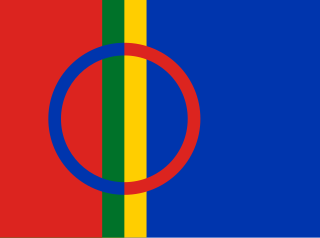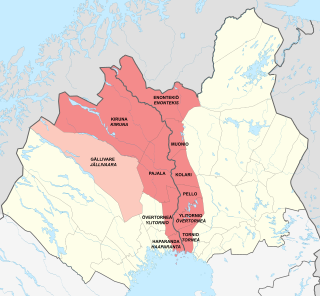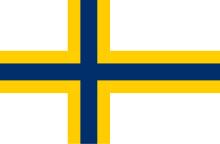
The demography of Sweden is monitored by the Statistiska centralbyrån. Sweden's population was 10,555,448, making it the 15th-most populous country in Europe after Czech Republic, the 10th-most populous member state of the European Union, and the 87th-most populous country in the world. The total fertility rate was rated at 1.66 in 2020, which is far below the replacement rate of 2.1.

Sápmi is the cultural region traditionally inhabited by the Sámi people. Sápmi is in Northern Europe and includes the northern parts of Fennoscandia, also known as the "Cap of the North".

Finland Swedish or Fenno-Swedish is a variety of the Swedish language and a closely related group of Swedish dialects spoken in Finland by the Swedish-speaking population, commonly also referred to as Finland Swedes, as their first language.

The Swedish-speaking population of Finland is a linguistic minority in Finland. They maintain a strong identity and are seen either as a separate cultural or linguistic group or, while not regularly, as a distinct nationality. They speak Finland Swedish, which encompasses both a standard language and distinct dialects that are mutually intelligible with the dialects spoken in Sweden and, to a lesser extent, other Scandinavian languages.
Sveriges Radio AB is Sweden's national publicly funded radio broadcaster. Sveriges Radio is a public limited company, owned by an independent foundation, previously funded through a licensing fee, the level of which is decided by the Swedish Riksdag. As of 1 January 2019, the funds stem from standard taxation. No advertising is permitted. Its legal status could be described as that of a quasi-autonomous non-governmental organization.

Meänkieli is a Finnic language or a group of distinct Finnish dialects spoken in the northernmost part of Sweden along the valley of the Torne River. Its status as an independent language is disputed, but in Sweden it is officially recognized as one of the country's five minority languages and is treated as a distinct language from standard Finnish. According to the Swedish National Association of Tornedalians, 70.000 individuals are able to understand Meänkieli, at least to some level.

Kvens are a Balto-Finnic ethnic minority in Norway. They are descended from Finnish peasants and fishermen who emigrated from the northern parts of Finland and Sweden to Northern Norway in the 18th and 19th centuries. In 1996, Kvens were granted minority status in Norway, and in 2005 the Kven language was recognized as a minority language in Norway.
Finns or Finnish people are a Baltic Finnic ethnic group native to Finland.

Meänmaa, or sometimes Torne Valley or Torne River Valley lies at the border of Sweden and Finland. It is named after the Torne River flowing through the valley and into the Gulf of Bothnia. Geographically the townships and municipalities that make up the area are Haparanda, Övertorneå, Pajala and Kiruna in Sweden, and Tornio, Ylitornio, Pello, Kolari, Muonio and Enontekiö in Finland. Culturally the highland Swedish municipality Gällivare is sometimes also considered part of Meänmaa due to the large share of Meänkieli-speaking population in it. Torne Valley should not be confused with Torne Valley Sub-region.

The Tornedalians are descendants of Finns who, at some point, settled in the areas of today's northern Sweden near the Torne Valley district and west from there. Tornedalians are a recognized national minority in Sweden.
In 1999, the Minority Language Committee of Sweden formally declared five official minority languages: Finnish, Sámi languages, Romani, Yiddish, and Meänkieli.

The Kven language is a Finnic language or a group of Finnish dialects spoken in the northernmost parts of Norway by the Kven people. For political and historical reasons, it received the status of a minority language in 2005 within the framework of the European Charter for Regional or Minority Languages. However, it is seen by some as a mutually intelligible dialect of the Finnish language, and grouped together with the Peräpohjola dialects such as Meänkieli, spoken in Torne Valley in Sweden. While it is often considered a dialect in Finland, it is officially recognized as a minority language in Norway and some Kven people consider it a separate language.

The two main official languages of Finland are Finnish and Swedish. There are also several official minority languages: three variants of Sami, as well as Romani, Finnish Sign Language, Finland-Swedish Sign Language and Karelian.

Swedish is the official language of Sweden and is spoken by the vast majority of the 10.23 million inhabitants of the country. It is a North Germanic language and quite similar to its sister Scandinavian languages, Danish and Norwegian, with which it maintains partial mutual intelligibility and forms a dialect continuum. A number of regional Swedish dialects are spoken across the country. In total, more than 200 languages are estimated to be spoken across the country, including regional languages, indigenous Sámi languages, and immigrant languages.
Russians in Finland or Russian Finns are a linguistic and ethnic minority in Finland. As of 2022, there are 93,535 Russian-speaking people, or 1.7% of population, in Finland. It is the largest linguistic minority in the country. However, many of Russian-speaking immigrants are ethnically Ingrian Finns and other Finno-Ugric peoples.

Finnish is a Uralic language of the Finnic branch, spoken by the majority of the population in Finland and by ethnic Finns outside of Finland. Finnish is one of the two official languages of Finland, alongside Swedish. In Sweden, both Finnish and Meänkieli are official minority languages. The Kven language, which like Meänkieli is mutually intelligible with Finnish, is spoken in the Norwegian counties Troms and Finnmark by a minority group of Finnish descent.
Swedification refers to the spread and/or imposition of the Swedish language, people and culture or policies which introduced these changes. In the context of Swedish expansion within Scandinavia, Swedification can refer to both the integration of Scania, Jemtland and Bohuslen in the 1600s and governmental policies regarding Sámi and Finns in northern Sweden during the 1800s and 1900s.
Anti-Finnish sentiment is the hostility, prejudice, discrimination or racism directed against Finns, Finland, or Finnish culture.

Sweden Finns' Day is an anniversary celebrated in Sweden on 24 February. The anniversary was approved by the Swedish Academy in 2010, and was held for the first time in 2011. 24 February was chosen as the date of the anniversary, as this was also the birthday of Carl Axel Gottlund, a collector of folk poetry and a defender of the status of the Finnish language. The purpose of the day is to celebrate the Sweden Finns and to recognize their history, language and culture as a part of Sweden's cultural heritage.














